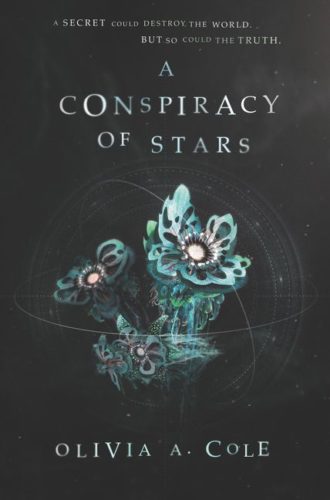Critics Lab: Our Goal — To Nurture Young Arts Reviewers of the Future
Editor’s Note: Alarmed at how quickly serious cultural coverage is disappearing in newspapers and magazines, The Arts Fuse is dedicated to keeping the venerable craft of arts criticism alive and well.
This is the first in a series of pages in which one of our critics, working with a young person, produces an arts review. In this case, poetry and music critic Eric Fishman collaborated with one of his sixth grade students, Bram Philip, to review A Conspiracy of Stars, a young adult sci-fi novel by Olivia A. Cole. Interestingly, they submitted two pieces — one a review written by Eric and revised by Bram, and the other written by Bram and revised by Eric. I think you will find the writing trenchant — and the “experiment” successful.
— Arts Fuse Editor-in-chief, Bill Marx
By Bram Philip
A Conspiracy of Stars by Olivia A. Cole, Harper Collins, $17.99

Fledgling critic Bram Philip.
Reading A Conspiracy of Stars is like walking down a long hallway, a doorway every fifteen-odd feet. You know when each doorway’s coming, but you have no way to predict what surprise might be tucked away behind it. Olivia A. Cole is an absolute genius at creating massively shocking revelations. A Conspiracy of Stars is probably one of the most well-written sci-fi novels I’ve ever read.
Not only does the author create perfect twists and discoveries in the storyline, but she also builds incredibly dynamic characters. In addition, she offers an implicit comparison between the environments on the fictional planet and Earth. This contrast delivers a forewarning about the way humans seek to control the environment.
The story takes place on a dense, hot globe, Faloiv. The humans live under rightfully imposed edicts of the native Faloii. The jungle is chock full of predators, and humans are dehydrated completely within minutes of being outside. It’s a planet only meant to be a stop as the human refugees flee Earth, but it turns into a home.
The author’s technique for the surprises and storyline building is masterful. Although the building of tension is not done consistently throughout the rising action, it is done cleverly when it is done. One example of the author’s tension building comes early on in the story:
“I’m surprised by the buzzgun she carries–more and more guards have them these days, and it’s jarring to see it slung so casually over her shoulder.”
This sentence shows the way the author builds suspense throughout the book. In the first phrase of this sentence, the author introduces the topic: guards carrying buzzguns. In the second, she says that the threat is increasing, and has been for awhile. Lastly, she caps off the sentence by saying that it’s reached the point where the guard have the buzzguns casually. This explanation, intensity change, and finish strategy is used well all through the book.
Probably the most impressive thing from my reading of the book was how revelations that don’t end up mattering to the storyline much were given equal gravity to the game-changing ones. This is something that you almost never see, when it’s challenging to tell from the noticeable buildup what the surprise will be like, including whether or not it will be important.
Olivia A. Cole delivers a fascinating message about how humans look to exert control over the environment as well as animals and other humans. It serves as a quiet warning about what can happen to the environment as well as humans, depending on the environmental context as well as the perspective of who’s in charge. When a large birdlike animal called a Philax breaks free from the labs near the beginning of the story, we see an example of how trying to control the environment can backfire: “The scientists from the Beak scramble to subdue the animal…One of those wings buffets a whitecoat, sending him sprawling.” I think that it was a message I had never seen before in a book, and its uniqueness really held me.
I think that A Conspiracy of Stars is a book worth reading from both the reviewer’s and the casual reader’s viewpoint. It’s an engaging book with an interesting lesson about trying to control the environment. All the combined elements, of dynamic characters, unexpected plot twists, and building of suspense make it a book I enjoyed reading. If you like it, An Anatomy of Beasts is the excellent sequel. As of this review, the third hasn’t been named yet, and who knows how many more there might be?
Bram Philip is a sixth grade student who enjoys programming, reading, and Dungeons and Dragons.
By Eric Fishman

Science fiction has long struggled with its public perception as trashy literature. For most people, the genre calls to mind acne-ridden teenage boys in sweatpants reading under Star Trek posters. Authors, critics — and guilty sci-fi loving adults — often feel the need to justify their tastes by explaining that the books they write or read are “better than the average sci-fi.” Ursula K. Le Guin, for example, was notoriously prickly when people attempted to identified her as a science fiction author. She described her reaction during an interview with the Paris Review: “Don’t shove me into your damn pigeonhole.”
These days, however, science fiction is having a resurgence. Le Guin was herself one of the instigators of a shift from science fiction’s historically narrow focus on thought experiments derived from the “hard sciences” — astronomy, chemistry, physics — to a broader consideration of sociological conundrums. This expansion, which has partly been driven by a break in the dominance of white men as both readers and writers of the genre, has been accompanied by a development in character complexity and literary nuance. Speculative fiction has also come to be used increasingly as a medium for social activism, intersecting at times with its neighboring genre, the dystopian novel.
Olivia A. Cole’s A Conspiracy of Stars, written for a young adult audience, follows many of these trends, even though it does not fit neatly into the genre of science fiction. Many of its features are drawn from fantasy, such as deliriously crafted flora and fauna and interspecies telepathic communication. The basic premise, though, is pure science fiction: survivors of an unspecified tragedy on Earth flee in a spaceship to a foreign planet. The protagonist is a middle school girl named Octavia (whose name is perhaps a reference to the speculative fiction author Octavia Butler), part of the first generation to be born on “Faloiv.”
As an elementary school teacher, I am often wary of assigning science fiction and fantasy novels for study with my class. The process of world building, although fascinating and clearly developmentally engrossing — I, too, read almost exclusively fantasy throughout my childhood — can at times draw attention away from the subtleties of character analysis.
Intriguingly, a 2017 study by Chris Gavaler and Dan Johnson seems to have partly confirmed this suspicion. They found that when readers were presented with two nearly identical texts, with the only difference being the replacement of words such as “door” with “portal” and “restaurant” with “spaceship,” they reported expending “greater effort to understand the world of the story, but less effort to understand the minds of the characters.” In other words, the trappings of science fiction limited the readers’ abilities to exercise empathy.
Thankfully, Cole limits the page count spent on detailed descriptions of otherworldly phenomena. Although “oxynets,” “skinsuits” and the like do make appearances, she does not rely on extraterrestrial technology as the engine for the novel. The surface of the book seems foreign, yet the deeper layers will likely feel familiar to many young adults. Octavia is stuck in the middle of her parents’ disintegrating marriage, experiences her first budding romance, and wrestles with anxieties caused by the fiercely competitive schooling system.
What truly drives the plot, however, is the twists and turns of Octavia’s attempts to understand a conspiracy among the leaders and scientific elite of the planet. Her parents are both “whitecoats,” scientists tasked with probing the secrets of the flora and fauna of Faloiv — including, it eventually emerges, the indigenous population, the Faloii. Octavia is also studying to be a whitecoat, and we witness her progressive disillusionment — and then outrage—as she confronts the violence perpetuated by her society.
Even when fantasy and science fiction novels claim to be “neutral” about social topics, there are agendas, often hidden beneath the surface. Much has been written, for example, about the problematic—and obscured—role race can play in the world building of fantasy novels. As adults helping to guide how children choose and read books, it’s crucial for us to consider these explicit and implicit messages.

Author Olivia A. Cole. Photo: Facebook.
In A Conspiracy of Stars, Cole engages directly with the impacts of colonialism. One way to read this novel is as a story about a young woman confronting her power and privilege for the first time. Through small observations made by Cole, we learn that Octavia is a person of color. On this world, though, her family and community are the ones attempting to settle a planet already populated by someone else. As Octavia begins to interact with the indigenous population, she wrestles with what this oppression means for her own identity. As she gazes down at a group of whitecoats from far away, she views them for the first time as a Faloii might:
From this height, I can’t make out any of their identities: just the colors of their clothing. I know not who but what each of them is. I can remember I time when I would have given anything to be wearing one of those white coats … Now it seems stupid. Wearing it would mean what, exactly? To [a Faloii’s] eyes, it might mean that I’m an invader; an alien who came to this planet in supposed peace and then brutalized the people and creatures who were here first.
This passage plays cleverly with the tropes of colonialism: the dehumanization and “alienation” of the other. But here, it’s her own people that Octavia begins to see as the “aliens.” And she must figure out what her own identity means for her role in fighting back against oppression. What does it mean for her to become an ally to the Faloii? At one moment, she witnesses a particular horror conducted by the whitecoats, and she desperately implores a Faloii to not blame her: “I didn’t know they were doing this, I tell him. He ignores me.” She is not excused from sharing the responsibility for what her people have done.
Will the setting and genre of this novel distract from the complex currents running beneath? Or is it precisely the freshness of this context that will allow young people to engage with these challenging questions? Cole deserves praise for the evocative allegory she has constructed. I hope that the young people who read this book are given chances to consider how they themselves are implicated in systems of power similar to the ones Octavia confronts. What can they learn from Octavia’s development as an “activist ally”? In the end, foreign worlds can have profound implications for our own.
Eric Fishman is an elementary school teacher, writer, and literary translator. You can find out more about his work here.

